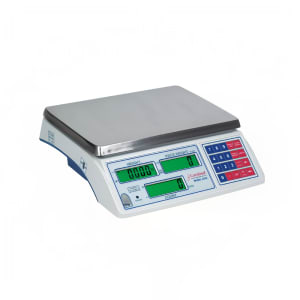Digital Price Computing Scales
Price computing scales are legal-for-trade scales that weigh foods and other items, then digitally display the results. They operate using built-in touchpads or via connection to a computer or cash register. More
Computing Scales: What You Need to Know
Whether you sell meats and cheeses at a deli, sell artisan coffee by the pound, or operate a roadside fruit stand, price computing scales are a vital part of your business. Various other operations, such as pay-by-the-pound buffets, self-serve frozen yogurt shops, and hardware stores, also rely on a computing scale to determine the price customers pay for their products.
Use these digital price computing scales to determine price at the point of sale for items such as produce, frozen yogurt, candy, nuts, and coffee. Alternatively, use these scales in advance to price items such as cuts of meats, seafood, and sliced deli cuts before packaging.
Electronic price computing scales are made of easy-to-clean stainless steel platforms, a base that may be plastic, and a display. Controls may be located on the scale or on a remote computer.
These digital computing scales are platform scales typically designed for countertop use with maximum capacities ranging from approximately 10 pounds to 250 pounds. Scales offer taring to exclude package weight from the total; other features include counting items using a preset weight, dual displays, and the capability to handle multiple transactions simultaneously.
Deli scales, also referred to as label printing scales, print out weights, prices, barcodes, and other item information often customizable by the operator.
Common Questions About Price Computing Scales
How do you use a deli scale?
Label printing scales and most other digital price scales are operated using the following steps, which may differ slightly depending on the unit:
- Program the tare weight if applicable.
- Place the product and container on the scale.
- Enter the price per pound, or select the correct PLU using the keypad or a computer.
- If you use a barcode printing scale, print out the label for the product.
What is a legal-for-trade scale?
Legal-for-trade scales are scales that have been given an NTEP (National Type Evaluation Program) Certificate of Conformance from the National Conference on Weights and Measures. In the United States, this certification is necessary for any scales used to determine the price of a product.
What does PLU code stand for?
PLU stands for "price look-up." PLU settings allow operators to select preset prices per weight or item. Units may have manual PLU buttons or connect to a computer where prices are stored.
How do hardware stores use computing scales?
Hardware stores that sell loose items such as nuts, bolts, and nails can use these scales to determine prices at the time of sale. Additionally, a piece-counting feature found on certain scales can be used for inventory purposes to determine the number of items on the scale based on the weight of a single item.
How do you use tare weight?
Tare weight allows operators to subtract the weight of a container or bag automatically from price calculations. For most scales, place the empty container on the platform and push the "tare" button. The weight on the display will reset to zero, and the weight of the container will be subtracted until it is reset.

